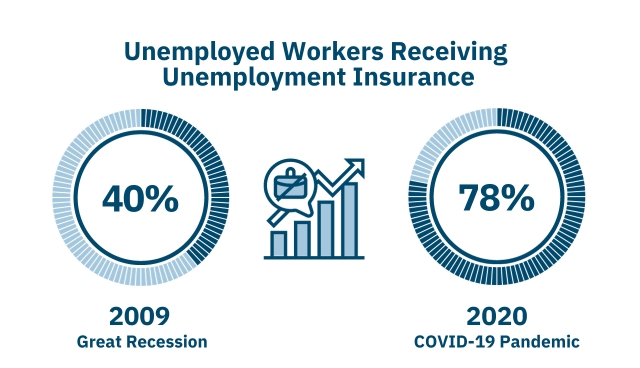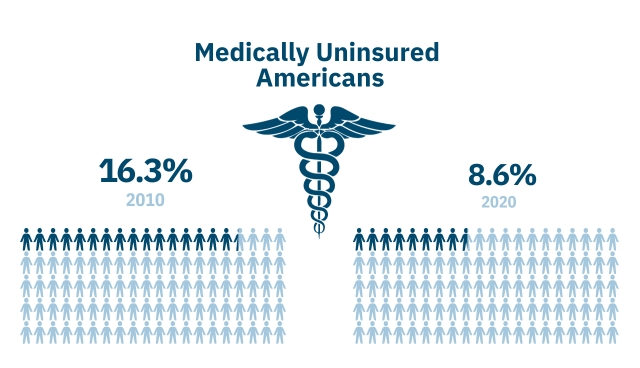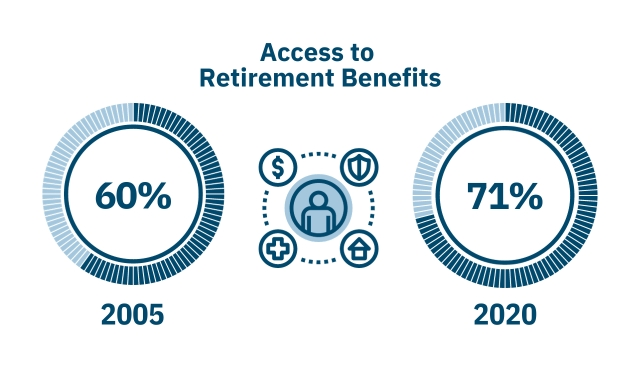
Then and Now: The Evolution of Key Worker Support Systems in the 21st Century
Nyerere Hodge, Stuart Andreason, and Carl E. Van Horn
November 8, 2023
https://doi.org/10.29338/wc2023-03
Download the full text of this paper (1,246 KB)
This is part two of a three-part series that brings together labor market, workforce, occupational, and educational trends since 2000 to tell a story of American workers through data. This is primarily a decennial retrospective, but some sections include additional years to shape a complete story. Part two looks at policy interventions related to unemployment, health care insurance, and retirement savings. The charts illustrate the mixed experiences of workers over this period.
The "Then and Now" series explores data broadly and granularly with a demographic lens, recognizing that general trends are not experienced universally across groups. We identify where opportunities for some workers have improved and where there may be a need for additional efforts to increase opportunities for enhanced economic mobility.
This is a story told primarily through charts and tables to serve as a visual depiction of how workers are experiencing the labor market. We bring together two decades of data and hope this informs workforce practitioners, policymakers, business leaders, and others as they double down in areas where the trends show positive signs of improvement and continue as change agents in areas where the trends are stagnant or regressing.
The three parts of this series are as follows:
- Earnings
- Labor Force Participation
- Unemployment
- Educational Attainment
Part 1: Key Trends and Transformations in the 21st Century Labor Market
- Unemployment Insurance
- Unemployment Spells
- Health Insurance Coverage
- Retirement Benefits
Part 2: The Evolution of Key Worker Support Systems in the 21st Century
- Earnings by Educational Attainment
- College/University Tuition
- Higher Education Grants and Loans
- Funding at Historically Black Colleges and Universities and Tribal Colleges and Universities
Part 3: The Changing Landscape of Education Outcomes and Funding in the 21st Century
Part two reviews the uptake of unemployment insurance over the last two decades and the affect pandemic-era policy had on coverage. It also looks at changes in health care coverage and trends in retirement savings approaches.
Part one looked at big labor market trends. We explored how median earnings have changed over time and whether they have kept up with inflation. We illustrated labor force participation and unemployment trends. We also explored whether achieving higher education benefited all workers. We explored these trends in the aggregate to understand the country’s direction as a whole, but with a demographic lens so we can see how experiences and outcomes have varied for different groups of workers, ultimately to better support an economy that works for all.
Part three will highlight the increasing earnings disparity between workers with and without a college degree. We’ll also trace tuition increases over the last two decades and how grant aid and student loan reliance changed in conjunction. We will also illustrate funding trends to historically Black colleges and universities (HBCUs) and Tribal colleges and universities (TCUs).
We proceed with an excerpt from part two, The Evolution of Key Worker Support Systems in the 21st Century.
The COVID-19 pandemic led to the biggest shock to the unemployment insurance program since its inception in 1935. Millions of workers were laid off as businesses closed. To help ease the financial burden of those workers, Congress passed legislations to expand unemployment insurance eligibility. The infographic below shows the unemployment insurance recipiency rate skyrocketed in 2020, compared to any other year over the last two decades. 78 percent of unemployed workers received unemployment benefits in 2020, nearly double the Great Recession-era high of 40 percent in 2009.

The Patient Protection and Affordable Care Act (ACA) passed in 2010 and one of its goals was to expand health care coverage. We see in the infographic below that the medically uninsured rate was increasing over first decade of the century, reaching 16.3 percent in 2010. After ACA passed, the uninsured rate declined by almost half to 8.6 percent. However, the full report shows this steep decline was not uniform for all groups of Americans.

In addition to more Americans having health insurance, more Americans also have retirement benefits. From 2005 to 2020, access to retirement benefits increased to 71 percent from 60 percent. However, the full report shows participation grew much slower from 50 percent to 55 percent, over the same period.

The full report explores these topics in more detail, providing additional insight into unemployment insurance and spells, health insurance coverage, and retirement benefits.
Nyerere "Nye" Hodge is a senior research analyst for community and economic development in the Atlanta Fed's Center for Workforce and Economic Opportunity. Stuart Andreason is managing director of workforce Innovation at the Burning Glass Institute. Carl Van Horn is distinguished professor of public policy at Rutgers University and director of the Heldrich Center for Workforce Development at Rutgers.


